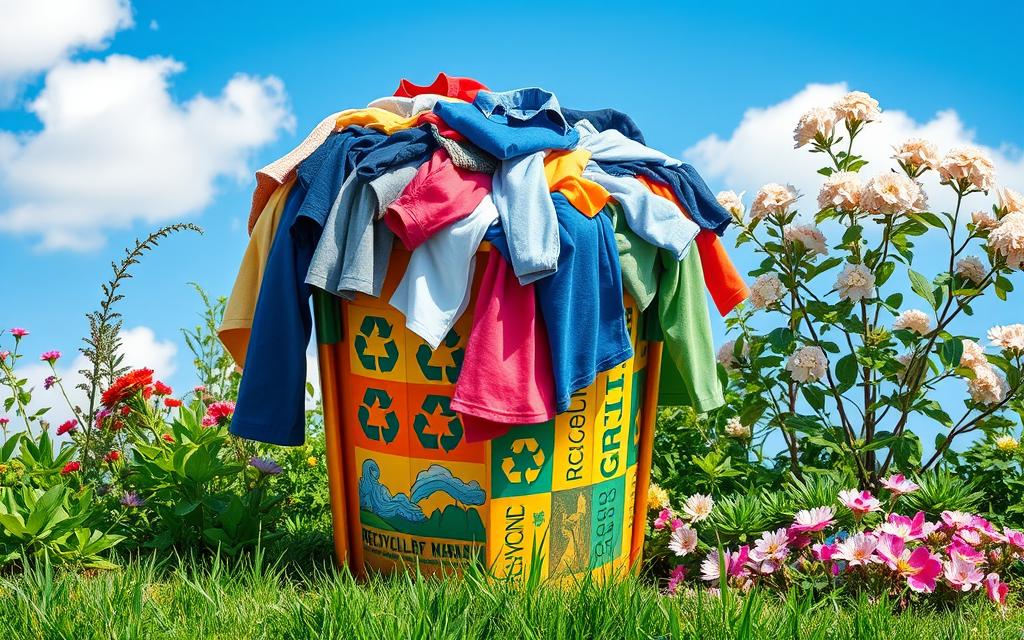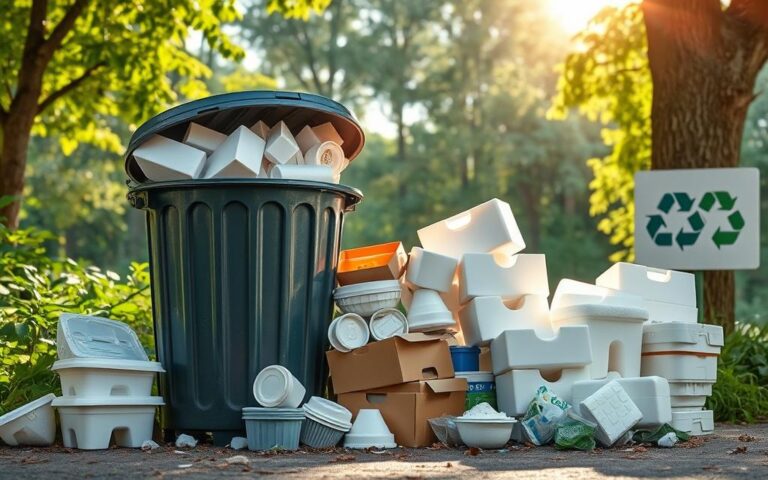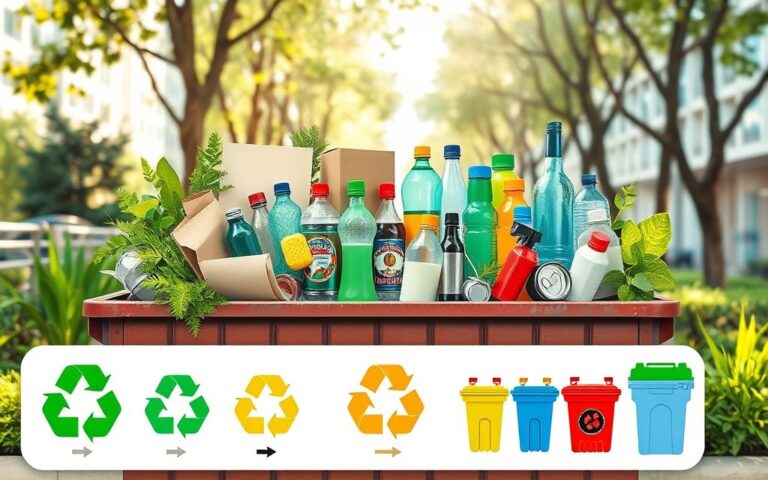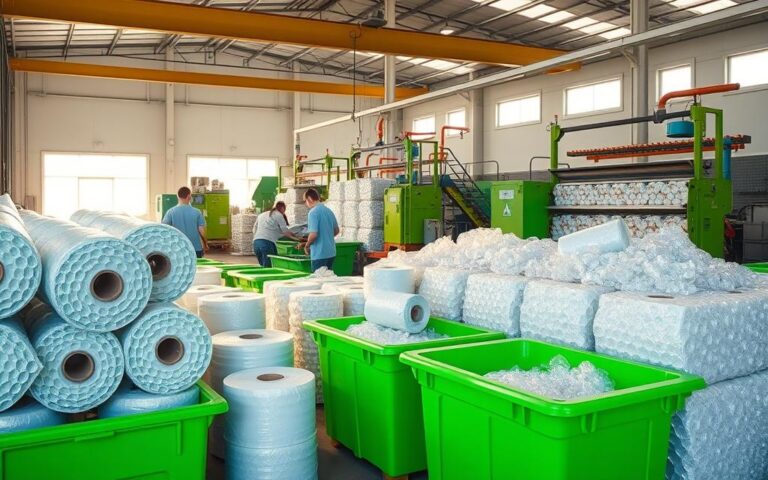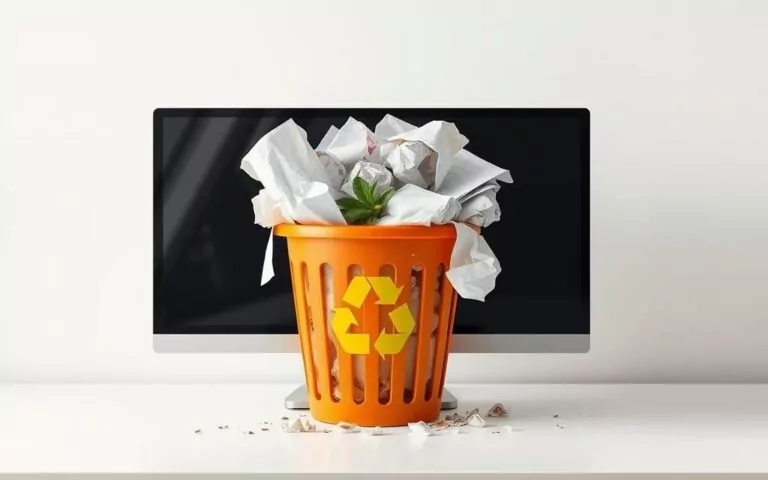Can Clothes Go in the Recycling Bin? Proper Disposal Tips
Can we just throw clothes into the recycling bin? It’s not as simple as it sounds. Recycling clothes helps cut down on textile waste. But not everyone knows how to properly dispose of them. Putting clothes in your recycling bin can actually contaminate other recyclables.
It turns out, regular curbside collection services can’t handle clothing. We need to find different ways to recycle textiles.
So, what should we do instead of binning them? Don’t toss them out or assume they’re recyclable. You could donate to charities or look into textile recycling schemes. These steps help give your clothes a second life and are better for the planet. For tips on recycling clothes correctly, visit this helpful site.
Understanding Textile Waste and Its Impact
Textile waste is a growing issue as people notice their buying habits. The rise of fast fashion has a big textile waste impact worldwide. To understand this, we need to consider several important statistics.
Global Textile Waste Statistics
In 2017, about 16.9 million tons of textiles were made. But, only 13.6% were recycled. Landfills got more than 10 million tons of this waste, mainly because there’s little demand for donated clothes. It’s shocking that just 0.1% of thrown away textiles are made into new clothes. In 2018, about 17 million tons of textile waste filled landfills. This was 5.8% of all the trash collected that year.
| Year | Total Textile Waste (million tons) | Recycled Percentage | Waste Sent to Landfills (million tons) |
|---|---|---|---|
| 2017 | 16.9 | 13.6% | 10+ |
| 2018 | 17 | 14.7% | 11.3 |
Environmental Effects of Textile Disposal
The environmental effects of clothing disposal are serious. Clothes can take over 200 years to break down in landfills. Fast fashion is a major player in this crisis. If we don’t change our ways, the amount of waste from Americans could triple. The textile industry causes about 10% of the world’s carbon emissions. This shows how urgent it is to deal with this problem.
Recycling textiles is tough, especially natural fibres, compared to synthetics. It’s thought that only 15% of used textiles are gathered for reuse or recycling. This means most textile waste either goes to landfills or gets burnt.
Why Recycling Clothes Is Important
The rise in fashion consumption has brought big challenges, including textile waste. The fast fashion industry has grown quickly. Now, people buy clothes more than ever without thinking of the impact. Nearly 60% of produced clothing is thrown away within a year. This creates a culture where throwing things away is normal. We need to understand how important it is to recycle clothes to reduce harm to our planet.
The Growth of Fast Fashion
Fast fashion plays a big role in how often clothes are thrown away. Only 15% of clothes are recycled or given away. The rest, about 85%, goes to landfills. This issue is getting worse. In the UK, about 300,000 tonnes of clothes are thrown away each year. The textile industry is also a big source of global greenhouse gas emissions, around 10%. This shows we need better solutions, like recycling clothes, now more than ever.
Textile Lifespan and Disposal Rates
Textiles don’t last long today, with many items being tossed after just a few months. Modern materials can stay in landfills for over 200 years before they break down. Textiles make up 5% of what’s in landfills. It’s crucial we start recycling more. Recycling clothes helps reduce the strain on landfills and cuts down carbon emissions. Just recycling one bag of clothes per household in the UK can save enough energy to heat 400,000 homes. This shows just how big an impact recycling clothes can have in fighting against the fast fashion trend and helping our environment.
| Statistics | Details |
|---|---|
| Clothing Waste in Landfills | Textiles represent 5% of landfill waste. |
| Recycling Rate | Only 15% of clothing produced is recycled or donated. |
| Garment Lifespan | Clothing can remain in landfills for up to 200 years. |
| Annual Clothing Disposal in the UK | 300,000 tonnes of clothes are discarded per year. |
| Greenhouse Gas Emissions | The global fashion industry contributes to 10% of emissions. |
| Carbon Savings | Recycling a black bag of clothing can heat 400,000 homes. |
Can Clothes Go in the Recycling Bin?
Is it okay to put clothes in the recycling bin? This question often causes confusion. It’s vital to know the right steps for recycling clothes effectively. By following the right guidelines, we avoid wasting resources and tackle textile waste.
Guidelines for Recycling Textiles
Not every piece of clothing should end up in your recycle bin. Items you can recycle include:
- Clothing
- Footwear
- Accessories
- Linens
- Other textile items
In Baltimore City, you can take old clothes and textiles to one of five Residential Drop-off Centers. Helpsy, a Certified B Corporation, works with many states to collect unwanted clothes. Some items will be reused worldwide; others will be recycled into items like insulation. Despite 95% of textiles being recyclable, sadly, only 15% are currently recycled.
Common Misconceptions About Recycling Clothes
It’s important to clear up myths about recycling clothes. Many think all fabrics can be recycled in municipal bins. That’s not true. Materials like polyester and nylon won’t break down in landfills and can linger for hundreds of years. While rayon and lyocell break down slowly and release methane, natural fibres like cotton decompose and become CO2. This process isn’t as harmful to the environment.
Eco-Friendly Alternatives to Bin Disposal
Exploring ways to reduce textile waste is key. Instead of throwing unwanted clothes away, think about reselling them or giving them to charity. Doing this helps avoid waste and supports the community, benefiting many people.
Reselling Your Unwanted Clothes
Reselling clothes is a green move that gives garments a new life. Sites like eBay and Poshmark are popular for selling used fashion. For luxury items, The RealReal is a great option, while thredUP pays you for clothes you sell. This approach lessens fast fashion’s effect on our planet.
Donating to Charitable Organisations
Donating clothes is another powerful way to cut waste and help those less fortunate. Charities like Goodwill and the Salvation Army welcome clothing donations. However, remember, a small amount of donations actually stays local. Some contribute globally, like Soles4Souls, which collects shoes. Services like Donation Town make it easy to find local charities to donate to, ensuring your actions make a broad impact.
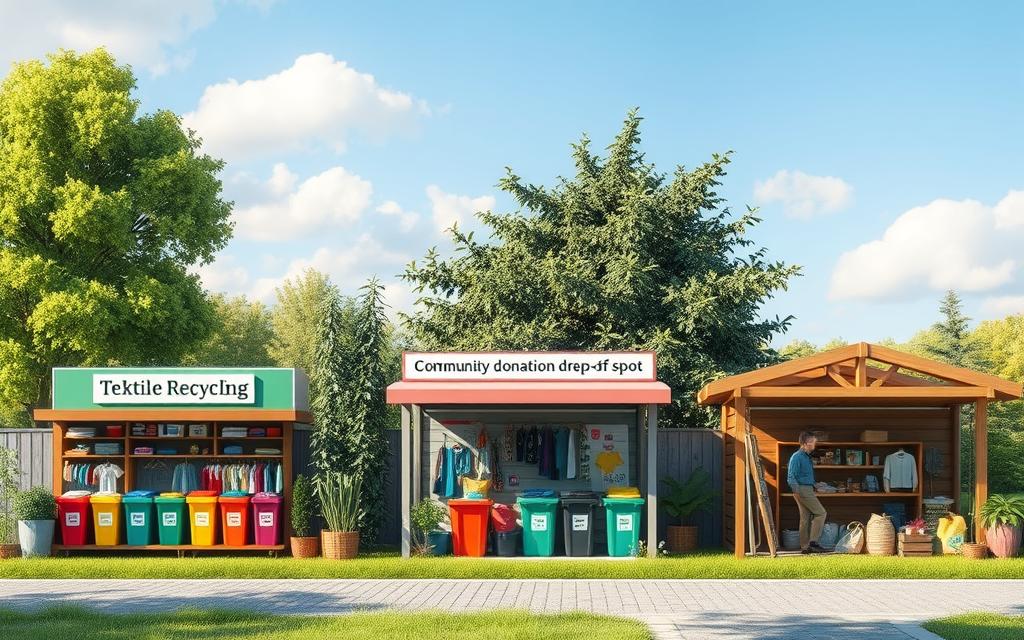
| Action | Advantages |
|---|---|
| Reselling Clothes | Extends garment lifespan, generates income, and promotes second-hand fashion. |
| Donating Clothes | Supports community need, reduces waste in landfills, and aids charitable organisations. |
Donation and Resale Options
Finding where to donate unused clothes is now simple. Many feel good giving to charity, while some like making money by reselling. By looking at local shops and online platforms, we all help cut down textile waste.
Local Charities and Thrift Stores
Donating to local thrift stores and charities is a great choice. These places take different kinds of clothes for those in need. Think about the season of the place you’re donating to.
Here are some famous charities:
- Oxfam – Fights poverty and takes various clothing.
- Salvation Army – Sells donated clothes in its shops to fund social programmes.
- Dress for Success – Aims to help women entering the workforce by accepting professional clothes.
Thrift stores need quality items. Some want only goods in fine shape, while others accept minor defects. Always ask stores what they prefer.
Online Reselling Platforms
Online platforms make selling clothes easy today. They link sellers to buyers, breathing new life into used clothes. Here are some popular sites:
- Depop – A trendy app for unique, second-hand fashion among the young.
- Poshmark – Here, people can sell and buy clothes, accessories, and home goods.
- ThredUp – Focuses on women’s and children’s clothes for easy selling of lightly used items.
Selling online helps financially and supports sustainable living by extending clothes’ lives. Whether donating or reselling, it aids in fighting textile waste.
Upcycling and Creative Reuse
Textile waste is a big problem today, but upcycling clothes offers a clever answer. This process helps people turn old clothes into something useful and attractive. With upcycling, we give old textiles new life and meaning. It’s all about reimagining what we can do with what we already have.
How to Upcycle Old Clothes
Starting to upcycle clothes is quite easy. There are many ways to make old clothes look and feel new again. Here are a few ideas:
- Cleaning Rags: Cut up old fabric to make rags for cleaning around the house.
- Dyeing Projects: Refresh your clothes’ colors with natural dyes.
- Pillow Stuffing: Turn scrap fabric into stuffing for pillows or toys.
- Craft Projects: Use old textiles in different crafts or sewing activities.
Check out this resource for more ideas. It’s full of great tips for reusing what you might throw away.
Community Upcycling Initiatives
Communities are joining forces to start upcycling projects. These activities encourage sustainable living and bring people together. Projects include:
| Initiative | Description |
|---|---|
| Clothing Swaps | Events where you can trade clothes you don’t want anymore. |
| Upcycling Workshops | Classes that show how to turn old fabrics into new creations. |
| Repair Cafés | Places where people meet to mend and upcycle damaged clothes. |
Getting involved in upcycling projects helps cut down on clothing waste. It also strengthens our community connections. By joining in, we all help keep millions of tons of clothes from ending up as waste.
Recycling Programs Specifically for Textiles
There’s a growing worry about textile waste. This has led to many recycling programs for clothes. These brand take-back initiatives make it easy for people to get rid of old clothes in a green way.
Many famous brands support these efforts. This helps everyone play a part in creating a sustainable future.
Brand Take-Back Programs
Different brands have started programs to recycle textiles. They offer rewards to encourage people to bring back used items. For example, H&M gives a 15% off card for each bag of used items you drop off.
Patagonia’s Worn Wear program offers store credit. The amount, between $10 and $100, depends on your items’ condition. These brand take-back initiatives not only push for recycling but also reward eco-conscious choices.
- Carter’s KidCycle gives 75 loyalty points for each shipment of old clothes.
- Levi’s offers a 20% off voucher for donating old jeans.
- Madewell hands out a $20 coupon for recycling denim. This encourages more sustainable garment choices.
- Soma’s Love Soma Rewards provides 125 points for each donated bra, with up to 250 points per month.
Local Recycling Facilities for Textiles
There are plenty of local textile recycling places, aside from brand programs. Helpsy, in the Northeast US, collects clothes. They offer free drop-off or home pickup options.
This program makes sure that 95% of what they collect is reused or recycled. Wearable Collections in NYC keeps 96% of textiles in use. They turn damaged items into something new.
| Facility Name | Location | Recycling Rate | Special Features |
|---|---|---|---|
| Helpsy | Northeast US | 95% | Free drop-off and home pickup |
| Wearable Collections | New York City | 96% | Converts textiles into rags or feedstock |
| Bra Recycling Agency (B.R.A.) | Various Locations | Unlimited bras recycled | Processes steel underwire for recycling |
Local textile recycling is key in battling textile waste. By joining these textile recycling programs, you help ensure clothes are disposed of right. This supports a circular economy that favours reuse and recycling.
Conclusion
The problem of textile waste needs urgent attention from both people and shops. Every year, around 300,000 tonnes of clothes are dumped in UK landfills. It’s really important to recycle clothes and help stop this problem.
Recycling clothes helps create a circular economy, which keeps materials out of landfills. In the UK, less than 20% of worn clothes are recycled. This shows there’s a lot of room for us to do better.
We need to support recycling efforts by big brands like H&M and Zara. Supporting local recycling projects can also make a big difference. Every step we take to dispose of clothes properly matters.
Our choices in donating, reselling, or recycling clothes are crucial in fighting the 92 million tonnes of clothes thrown away annually. Let’s work together for a sustainable future. Where recycling is just what we do.
FAQ
Can I put clothes in my recycling bin?
No, clothes can’t go in most recycling bins. You must dispose of them the right way to make sure they’re recycled properly.
What happens to textiles when they end up in landfills?
In landfills, textiles release methane, a harmful gas. Recycling them the right way helps reduce these emissions.
What is the impact of fast fashion on textile waste?
Fast fashion causes a lot of textile waste. Around 60% of clothes are thrown out within a year of being made. We need to recycle more to fight this problem.
How can I recycle my unwanted clothes properly?
For proper textile recycling, check with local charities and centres. Learn what materials they accept, as not all can be processed by city systems.
What are some eco-friendly alternatives to throwing clothes away?
Where can I donate my clothes locally?
Look for local charities and thrift stores for donations. Do some research to find the best places in your area and their donation requirements.
How can I upcycle my old clothes?
Transform old clothes into something new through upcycling. Create bags, home decor, or other items. Seek out local initiatives or workshops for ideas.
What are brand take-back programs?
Companies like Nike and Patagonia run these programs. They take back used clothes for recycling. This is a sustainable way to dispose of garments.
Are there local facilities dedicated to textile recycling?
Yes, some local centres focus on textile recycling. Check local waste management info to find where you can recycle clothes responsibly.

